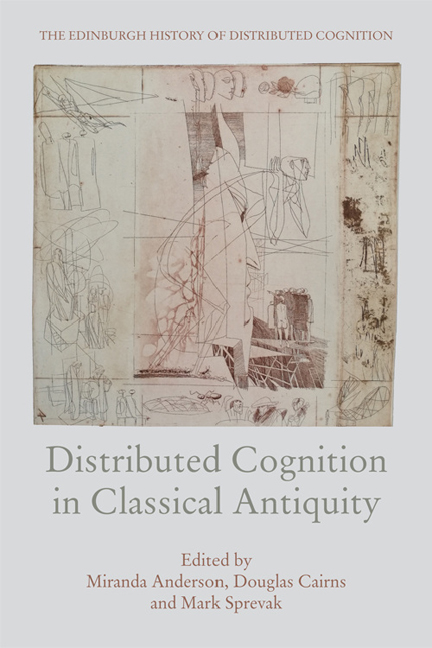Book contents
- Frontmatter
- Contents
- List of Illustrations
- Series Preface
- Miscellaneous Frontmatter
- 1 Distributed Cognition and the Humanities
- 2 Distributed Cognition and the Classics
- 3 Physical Sciences: Ptolemy's Extended Mind
- 4 Distributed Cognition and the Diffusion of Information Technologies in the Roman World
- 5 Mask as Mind Tool: A Methodology of Material Engagement
- 6 Embodied, Extended and Distributed Cognition in Roman Technical Practice
- 7 Roman-period Theatres as Distributed Cognitive Micro-ecologies
- 8 Cognition, Emotions and the Feeling Body in the Hippocratic Corpus
- 9 Enactivism and Embodied Cognition in Stoicism and Plato's Timaeus
- 10 Enargeia, Enactivism and the Ancient Readerly Imagination
- 11 Group Minds in Classical Athens? Chorus and Dēmos as Case Studies of Collective Cognition
- 12 One Soul in Two Bodies: Distributed Cognition and Ancient Greek Friendship
- 13 Distributed Cognition and its Discontents: A Dialogue across History and Artistic Genre
- Notes on Contributors
- Bibliography
- Index
3 - Physical Sciences: Ptolemy's Extended Mind
Published online by Cambridge University Press: 12 November 2019
- Frontmatter
- Contents
- List of Illustrations
- Series Preface
- Miscellaneous Frontmatter
- 1 Distributed Cognition and the Humanities
- 2 Distributed Cognition and the Classics
- 3 Physical Sciences: Ptolemy's Extended Mind
- 4 Distributed Cognition and the Diffusion of Information Technologies in the Roman World
- 5 Mask as Mind Tool: A Methodology of Material Engagement
- 6 Embodied, Extended and Distributed Cognition in Roman Technical Practice
- 7 Roman-period Theatres as Distributed Cognitive Micro-ecologies
- 8 Cognition, Emotions and the Feeling Body in the Hippocratic Corpus
- 9 Enactivism and Embodied Cognition in Stoicism and Plato's Timaeus
- 10 Enargeia, Enactivism and the Ancient Readerly Imagination
- 11 Group Minds in Classical Athens? Chorus and Dēmos as Case Studies of Collective Cognition
- 12 One Soul in Two Bodies: Distributed Cognition and Ancient Greek Friendship
- 13 Distributed Cognition and its Discontents: A Dialogue across History and Artistic Genre
- Notes on Contributors
- Bibliography
- Index
Summary
Introduction
Not much is known about Claudius Ptolemy's life, beyond what can be deduced from the astronomical observations recorded in his Syntaxis mathematica (better known as the Almagest), made between 127 and 141 CE at Alexandria, and the inscription he seems to have set up at nearby Canopus in 147. Otherwise he remains a nebulous figure, neither filling his own books with colourful anecdotes of his professional life as did the physician Galen, his near contemporary, nor enjoying the post-mortem attribution of fabulous biographical details as did other towering figures of ancient science like Pythagoras or Archimedes. The afterlife of his work was, however, extraordinarily robust. He became the author par excellence in astronomy and harmonics, to the extent that the works of his predecessors were largely obliterated in the wake of Ptolemy and his commentators.
Through the extraordinary breadth of his surviving texts persists a recurrent line of interest in putting the phenomena observed in the world to work in scientific theorisation, most often of a highly quantified kind. In particular, he is persistently interested in the natural and artificial instruments through which we perceive the world, in terms of how the natural ones may be aided and the artificial ones refined so as to provide the most reliable data. Ptolemy's inquiry into the mechanisms through which scientific observations are actually performed might be considered a second-order investigation with respect to the natural systems that are the explicit subjects of his texts. Yet such an investigation is mandatory for the precisely calibrated observational work Ptolemy recommends to his reader.
Far from simply listing the procedures and apparatus of scientific investigation, Ptolemy engages deeply with questions about the kinds of cognitive work they require and in turn perform. The body is presented as a composite of sensory and motor systems together with an array of faculties of judgement, all complexly intertwined and none functioning alone. The eye and ear are not mere relays for sensory data to a separate cognitive faculty, but are themselves an intrinsic part of the process of assessing geometric diagrams, harmonic tones, celestial bodies and other sensible phenomena. The eye may draw as well upon data mediated by computational tables, and Ptolemy describes the eye in action, moving through such tables to seek data or perform calculations.
- Type
- Chapter
- Information
- Distributed Cognition in Classical Antiquity , pp. 37 - 56Publisher: Edinburgh University PressPrint publication year: 2017



